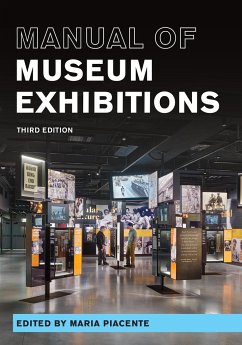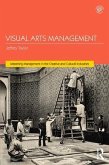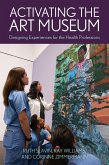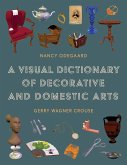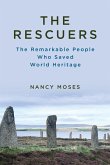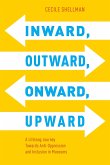Manual of Museum Exhibitions
Herausgeber: Piacente, Maria
Manual of Museum Exhibitions
Herausgeber: Piacente, Maria
- Broschiertes Buch
- Merkliste
- Auf die Merkliste
- Bewerten Bewerten
- Teilen
- Produkt teilen
- Produkterinnerung
- Produkterinnerung
Drawing on years of experience, Maria Piacente details the exhibition process in a straightforward way that can be easily adapted by institutions of any size. She and her contributing authors explore the exhibition development process in greater detail, providing the technical and practical methodologies museum professionals need today.
Andere Kunden interessierten sich auch für
![The Art Business The Art Business]() Jeffrey TaylorThe Art Business45,99 €
Jeffrey TaylorThe Art Business45,99 €![Visual Arts Management Visual Arts Management]() Jeffrey Taylor (USA State University of New York)Visual Arts Management65,99 €
Jeffrey Taylor (USA State University of New York)Visual Arts Management65,99 €![Activating the Art Museum Activating the Art Museum]() Ruth SlavinActivating the Art Museum53,99 €
Ruth SlavinActivating the Art Museum53,99 €![A Visual Dictionary of Decorative and Domestic Arts A Visual Dictionary of Decorative and Domestic Arts]() Nancy OdegaardA Visual Dictionary of Decorative and Domestic Arts78,99 €
Nancy OdegaardA Visual Dictionary of Decorative and Domestic Arts78,99 €![The Rescuers The Rescuers]() Nancy MosesThe Rescuers36,99 €
Nancy MosesThe Rescuers36,99 €![Inward, Outward, Onward, Upward Inward, Outward, Onward, Upward]() Cecile ShellmanInward, Outward, Onward, Upward32,99 €
Cecile ShellmanInward, Outward, Onward, Upward32,99 €![Managing Previously Unmanaged Collections Managing Previously Unmanaged Collections]() Angela KippManaging Previously Unmanaged Collections42,99 €
Angela KippManaging Previously Unmanaged Collections42,99 €-
-
-
Drawing on years of experience, Maria Piacente details the exhibition process in a straightforward way that can be easily adapted by institutions of any size. She and her contributing authors explore the exhibition development process in greater detail, providing the technical and practical methodologies museum professionals need today.
Produktdetails
- Produktdetails
- A Lord Cultural Resources Book
- Verlag: Bloomsbury Publishing Plc
- Third Edition
- Seitenzahl: 480
- Erscheinungstermin: 9. Februar 2022
- Englisch
- Abmessung: 244mm x 180mm x 25mm
- Gewicht: 1184g
- ISBN-13: 9781538152812
- ISBN-10: 1538152819
- Artikelnr.: 62074532
- Herstellerkennzeichnung
- Libri GmbH
- Europaallee 1
- 36244 Bad Hersfeld
- gpsr@libri.de
- A Lord Cultural Resources Book
- Verlag: Bloomsbury Publishing Plc
- Third Edition
- Seitenzahl: 480
- Erscheinungstermin: 9. Februar 2022
- Englisch
- Abmessung: 244mm x 180mm x 25mm
- Gewicht: 1184g
- ISBN-13: 9781538152812
- ISBN-10: 1538152819
- Artikelnr.: 62074532
- Herstellerkennzeichnung
- Libri GmbH
- Europaallee 1
- 36244 Bad Hersfeld
- gpsr@libri.de
Maria Piacente has spent more than 25 years in the global cultural sector, specializing in interpretive planning, exhibition development, and project management for cultural projects of all sizes, ranging in scope from art to science to history. Formerly the Vice President of Exhibitions and Events with Lord Cultural Resources, Maria is currently the Senior Vice President for Exhibitions and Galleries at the Royal Ontario Museum.
Preface
Acknowledgements
1.Introduction: The Exhibition Planning Process by Maria Piacente
Part I: Why?
2. Museums and their Exhibitions by Brad King
2.1. The Trust Factor
2.2. Exhibitions as Communication Platforms
2.3. Museums as Activist Institutions
2.4. The Way Forward
3. Where Do Exhibition Ideas Come From? by Barry Lord and Maria Piacente
3.1. Research-Based and Market-Driven Exhibitions
3.2. Planning for Exhibition Research
Part II: Where?
4. Exhibition Facilities by Sean Stanwick and Heather Maximea
4.1. A World of Exhibition Spaces
4.2. Design Criteria for Exhibition Spaces
4.3. Exhibition Space Characteristics
4.4. Exhibition Gallery Security
4.5. Accessibility, Adjacency and Flow
Part III: What?
5. Permanent Collection Displays by Katherine Molineux
5.1. Planning for Permanent Collection Exhibitions
5.2. Changing Permanent Collection Displays
5.3. Interpreting Collections
5.4. Modes of Display
6. It's Not Always About Collections by Katherine Molineux
6.1. Idea Exhibitions
6.2. Children's Exhibitions
6.3. Living History Exhibitions
6.4. Science Exhibitions
6.5. Digital Immersive Exhibitions
Case Study: Weston Innovation Learning Centre, Terms of Engagement at the
Ontario Science Centre, by Lesley Lewis and Kevin von Apen
7.Virtual Exhibitions by Sarah Hill
7.1. What is a Virtual Exhibition?
7.2. Why Develop a Virtual Exhibition?
7.3. Thinking About Digital Audiences
7.4. Virtual Exhibition Considerations
7.5. Virtual Exhibition Development Process
7.6. Tips for Smaller Museums that Want to go Digital
Case Study: Extending the Life of a Travelling Exhibition, Museum of
International Folk Art, Santa Fe, United States
8. Temporary Exhibitions by Maria Piacente and Katherine Molineux
8.1. Types of Exhibitions in a Temporary Exhibition Program
8.2. Managing a Temporary Exhibition Program
8.3. Making Space for Temporary Exhibitions
8.4. Public and Educational Programming
8.5. Marketing and Public Relations
8.6. Funding and Resourcing a Temporary Exhibition Program
8.7. Generating Revenue
9. Travelling Exhibitions by Maria Piacente
9.1. Why Create a Travelling Exhibition Program?
9.2. Strategize for Success
9.3. Staff and Professional Resources
9.4. Loan Agreements
9.5. Designing and Preparing an Exhibition for Travel
9.6. Managing the Tour
9.7. Borrowers and Organizers
Case Study: Natural History Museum London's Touring Exhibition Program, An
Interview with Jan English, Head of Touring Exhibitions
Interview: Travelling Exhibitions in a Changing World, with Antonio
Rodriguez, Chairman of the Board, International Committee for Exhibition
Exchange (ICEE)
Part IV: Who?
10. Exhibitions and DEAI by Maria Piacente and Karen Carter
10.1. Implications for Exhibitions
10.2. Reflections: Fulfillment of Our Promise
Case Study: Activating Change: DEAI, Community and Evaluation, An Interview
with Cheryl Blackman, Director of Museums and Heritage Services for the
City of Toronto, Canada
11. Curiosity and Motivation by Shiralee Hudson Hill and Barbara Soren
11.1. Cultivating Curiosity and Activating Change
11.2. Learning and Exhibitions
11.3. Understanding Audience Experiences, Motivations, and Preferences in
Exhibitions
12. Evaluation
12.1. Measuring Success by Gail Lord
12.2. Before, During, and After: Front-End, Formative, Remedial and
Summative
12.3. Evaluation by Duncan Grewcock
12.4. Qualitative and Quantitative Audience by Barbara Soren and Jackie
Armstrong
Case Study: University of Michigan Museum of Natural History by Barbara
Soren
Part V: How?
13. Who is involved in the Exhibition Process? by Maria Piacente
13.1. Roles and Responsibilities
13.2. Teams and Committees
13.3. Contracting Expertise
13.4. Making Decisions
Case Study: Oakland Museum of California Exhibition Process with Valerie
Huaco
Case Study: Roles and Responsibilities in a Small Museum: The Central Bank
Museum of Trinidad and Tobago
14. Preparing the Exhibition Brief by Maria Piacente
14.1. Formulating the Exhibition Concept
14.2. Exhibition Brief
Case Study: Canada Day 1 Travelling Exhibition
15. Interpretive Planning by Maria Piacente
15.1. Pre-Planning, Research and Visioning
15.2. Interpretive Strategy
15.3. Organizational and Thematic Frameworks
15.4. Organizational and Thematic Frameworks from around the World
15.5. Communication Objectives
15.6. Interpretive Plan
Case Study: University of Michigan Museum of Natural History, Exploring
Michigan
Case Study: Interpretive Planning for the Capitol Visitor Center,
Exhibition Hall
16. Content Development by Lisa Wright
16.1. Research Planning
16.2. Collections Research and Selection
16.3. Exhibition Text by Patchen Barss
16.4. Image Research and Procurement
16.5. Hands-On Exhibits, Models, and Dioramas
16.6. Multimedia Exhibits
16.7. Subject Matter Experts
Case Study: Working with Subject Matter Experts: Canadian Museum of
Immigration at Pier 21
Case Study: Creating with Community: Bunjilaka Aboriginal Culture Center
Case Study: Indigenous-Led Design and Content Development: Canada's
Diversity Gardens
17. Design by Yvonne Tang and James Bruer
17.1. Exhibition Design
17.2. Exhibition Display Cases by Mike Chaplin
17.3. Lighting Design by Kevin Shaw
17.4. Green Design
Case Study: Exhibitions and Museums
Acknowledgements
1.Introduction: The Exhibition Planning Process by Maria Piacente
Part I: Why?
2. Museums and their Exhibitions by Brad King
2.1. The Trust Factor
2.2. Exhibitions as Communication Platforms
2.3. Museums as Activist Institutions
2.4. The Way Forward
3. Where Do Exhibition Ideas Come From? by Barry Lord and Maria Piacente
3.1. Research-Based and Market-Driven Exhibitions
3.2. Planning for Exhibition Research
Part II: Where?
4. Exhibition Facilities by Sean Stanwick and Heather Maximea
4.1. A World of Exhibition Spaces
4.2. Design Criteria for Exhibition Spaces
4.3. Exhibition Space Characteristics
4.4. Exhibition Gallery Security
4.5. Accessibility, Adjacency and Flow
Part III: What?
5. Permanent Collection Displays by Katherine Molineux
5.1. Planning for Permanent Collection Exhibitions
5.2. Changing Permanent Collection Displays
5.3. Interpreting Collections
5.4. Modes of Display
6. It's Not Always About Collections by Katherine Molineux
6.1. Idea Exhibitions
6.2. Children's Exhibitions
6.3. Living History Exhibitions
6.4. Science Exhibitions
6.5. Digital Immersive Exhibitions
Case Study: Weston Innovation Learning Centre, Terms of Engagement at the
Ontario Science Centre, by Lesley Lewis and Kevin von Apen
7.Virtual Exhibitions by Sarah Hill
7.1. What is a Virtual Exhibition?
7.2. Why Develop a Virtual Exhibition?
7.3. Thinking About Digital Audiences
7.4. Virtual Exhibition Considerations
7.5. Virtual Exhibition Development Process
7.6. Tips for Smaller Museums that Want to go Digital
Case Study: Extending the Life of a Travelling Exhibition, Museum of
International Folk Art, Santa Fe, United States
8. Temporary Exhibitions by Maria Piacente and Katherine Molineux
8.1. Types of Exhibitions in a Temporary Exhibition Program
8.2. Managing a Temporary Exhibition Program
8.3. Making Space for Temporary Exhibitions
8.4. Public and Educational Programming
8.5. Marketing and Public Relations
8.6. Funding and Resourcing a Temporary Exhibition Program
8.7. Generating Revenue
9. Travelling Exhibitions by Maria Piacente
9.1. Why Create a Travelling Exhibition Program?
9.2. Strategize for Success
9.3. Staff and Professional Resources
9.4. Loan Agreements
9.5. Designing and Preparing an Exhibition for Travel
9.6. Managing the Tour
9.7. Borrowers and Organizers
Case Study: Natural History Museum London's Touring Exhibition Program, An
Interview with Jan English, Head of Touring Exhibitions
Interview: Travelling Exhibitions in a Changing World, with Antonio
Rodriguez, Chairman of the Board, International Committee for Exhibition
Exchange (ICEE)
Part IV: Who?
10. Exhibitions and DEAI by Maria Piacente and Karen Carter
10.1. Implications for Exhibitions
10.2. Reflections: Fulfillment of Our Promise
Case Study: Activating Change: DEAI, Community and Evaluation, An Interview
with Cheryl Blackman, Director of Museums and Heritage Services for the
City of Toronto, Canada
11. Curiosity and Motivation by Shiralee Hudson Hill and Barbara Soren
11.1. Cultivating Curiosity and Activating Change
11.2. Learning and Exhibitions
11.3. Understanding Audience Experiences, Motivations, and Preferences in
Exhibitions
12. Evaluation
12.1. Measuring Success by Gail Lord
12.2. Before, During, and After: Front-End, Formative, Remedial and
Summative
12.3. Evaluation by Duncan Grewcock
12.4. Qualitative and Quantitative Audience by Barbara Soren and Jackie
Armstrong
Case Study: University of Michigan Museum of Natural History by Barbara
Soren
Part V: How?
13. Who is involved in the Exhibition Process? by Maria Piacente
13.1. Roles and Responsibilities
13.2. Teams and Committees
13.3. Contracting Expertise
13.4. Making Decisions
Case Study: Oakland Museum of California Exhibition Process with Valerie
Huaco
Case Study: Roles and Responsibilities in a Small Museum: The Central Bank
Museum of Trinidad and Tobago
14. Preparing the Exhibition Brief by Maria Piacente
14.1. Formulating the Exhibition Concept
14.2. Exhibition Brief
Case Study: Canada Day 1 Travelling Exhibition
15. Interpretive Planning by Maria Piacente
15.1. Pre-Planning, Research and Visioning
15.2. Interpretive Strategy
15.3. Organizational and Thematic Frameworks
15.4. Organizational and Thematic Frameworks from around the World
15.5. Communication Objectives
15.6. Interpretive Plan
Case Study: University of Michigan Museum of Natural History, Exploring
Michigan
Case Study: Interpretive Planning for the Capitol Visitor Center,
Exhibition Hall
16. Content Development by Lisa Wright
16.1. Research Planning
16.2. Collections Research and Selection
16.3. Exhibition Text by Patchen Barss
16.4. Image Research and Procurement
16.5. Hands-On Exhibits, Models, and Dioramas
16.6. Multimedia Exhibits
16.7. Subject Matter Experts
Case Study: Working with Subject Matter Experts: Canadian Museum of
Immigration at Pier 21
Case Study: Creating with Community: Bunjilaka Aboriginal Culture Center
Case Study: Indigenous-Led Design and Content Development: Canada's
Diversity Gardens
17. Design by Yvonne Tang and James Bruer
17.1. Exhibition Design
17.2. Exhibition Display Cases by Mike Chaplin
17.3. Lighting Design by Kevin Shaw
17.4. Green Design
Case Study: Exhibitions and Museums
Preface
Acknowledgements
1.Introduction: The Exhibition Planning Process by Maria Piacente
Part I: Why?
2. Museums and their Exhibitions by Brad King
2.1. The Trust Factor
2.2. Exhibitions as Communication Platforms
2.3. Museums as Activist Institutions
2.4. The Way Forward
3. Where Do Exhibition Ideas Come From? by Barry Lord and Maria Piacente
3.1. Research-Based and Market-Driven Exhibitions
3.2. Planning for Exhibition Research
Part II: Where?
4. Exhibition Facilities by Sean Stanwick and Heather Maximea
4.1. A World of Exhibition Spaces
4.2. Design Criteria for Exhibition Spaces
4.3. Exhibition Space Characteristics
4.4. Exhibition Gallery Security
4.5. Accessibility, Adjacency and Flow
Part III: What?
5. Permanent Collection Displays by Katherine Molineux
5.1. Planning for Permanent Collection Exhibitions
5.2. Changing Permanent Collection Displays
5.3. Interpreting Collections
5.4. Modes of Display
6. It's Not Always About Collections by Katherine Molineux
6.1. Idea Exhibitions
6.2. Children's Exhibitions
6.3. Living History Exhibitions
6.4. Science Exhibitions
6.5. Digital Immersive Exhibitions
Case Study: Weston Innovation Learning Centre, Terms of Engagement at the
Ontario Science Centre, by Lesley Lewis and Kevin von Apen
7.Virtual Exhibitions by Sarah Hill
7.1. What is a Virtual Exhibition?
7.2. Why Develop a Virtual Exhibition?
7.3. Thinking About Digital Audiences
7.4. Virtual Exhibition Considerations
7.5. Virtual Exhibition Development Process
7.6. Tips for Smaller Museums that Want to go Digital
Case Study: Extending the Life of a Travelling Exhibition, Museum of
International Folk Art, Santa Fe, United States
8. Temporary Exhibitions by Maria Piacente and Katherine Molineux
8.1. Types of Exhibitions in a Temporary Exhibition Program
8.2. Managing a Temporary Exhibition Program
8.3. Making Space for Temporary Exhibitions
8.4. Public and Educational Programming
8.5. Marketing and Public Relations
8.6. Funding and Resourcing a Temporary Exhibition Program
8.7. Generating Revenue
9. Travelling Exhibitions by Maria Piacente
9.1. Why Create a Travelling Exhibition Program?
9.2. Strategize for Success
9.3. Staff and Professional Resources
9.4. Loan Agreements
9.5. Designing and Preparing an Exhibition for Travel
9.6. Managing the Tour
9.7. Borrowers and Organizers
Case Study: Natural History Museum London's Touring Exhibition Program, An
Interview with Jan English, Head of Touring Exhibitions
Interview: Travelling Exhibitions in a Changing World, with Antonio
Rodriguez, Chairman of the Board, International Committee for Exhibition
Exchange (ICEE)
Part IV: Who?
10. Exhibitions and DEAI by Maria Piacente and Karen Carter
10.1. Implications for Exhibitions
10.2. Reflections: Fulfillment of Our Promise
Case Study: Activating Change: DEAI, Community and Evaluation, An Interview
with Cheryl Blackman, Director of Museums and Heritage Services for the
City of Toronto, Canada
11. Curiosity and Motivation by Shiralee Hudson Hill and Barbara Soren
11.1. Cultivating Curiosity and Activating Change
11.2. Learning and Exhibitions
11.3. Understanding Audience Experiences, Motivations, and Preferences in
Exhibitions
12. Evaluation
12.1. Measuring Success by Gail Lord
12.2. Before, During, and After: Front-End, Formative, Remedial and
Summative
12.3. Evaluation by Duncan Grewcock
12.4. Qualitative and Quantitative Audience by Barbara Soren and Jackie
Armstrong
Case Study: University of Michigan Museum of Natural History by Barbara
Soren
Part V: How?
13. Who is involved in the Exhibition Process? by Maria Piacente
13.1. Roles and Responsibilities
13.2. Teams and Committees
13.3. Contracting Expertise
13.4. Making Decisions
Case Study: Oakland Museum of California Exhibition Process with Valerie
Huaco
Case Study: Roles and Responsibilities in a Small Museum: The Central Bank
Museum of Trinidad and Tobago
14. Preparing the Exhibition Brief by Maria Piacente
14.1. Formulating the Exhibition Concept
14.2. Exhibition Brief
Case Study: Canada Day 1 Travelling Exhibition
15. Interpretive Planning by Maria Piacente
15.1. Pre-Planning, Research and Visioning
15.2. Interpretive Strategy
15.3. Organizational and Thematic Frameworks
15.4. Organizational and Thematic Frameworks from around the World
15.5. Communication Objectives
15.6. Interpretive Plan
Case Study: University of Michigan Museum of Natural History, Exploring
Michigan
Case Study: Interpretive Planning for the Capitol Visitor Center,
Exhibition Hall
16. Content Development by Lisa Wright
16.1. Research Planning
16.2. Collections Research and Selection
16.3. Exhibition Text by Patchen Barss
16.4. Image Research and Procurement
16.5. Hands-On Exhibits, Models, and Dioramas
16.6. Multimedia Exhibits
16.7. Subject Matter Experts
Case Study: Working with Subject Matter Experts: Canadian Museum of
Immigration at Pier 21
Case Study: Creating with Community: Bunjilaka Aboriginal Culture Center
Case Study: Indigenous-Led Design and Content Development: Canada's
Diversity Gardens
17. Design by Yvonne Tang and James Bruer
17.1. Exhibition Design
17.2. Exhibition Display Cases by Mike Chaplin
17.3. Lighting Design by Kevin Shaw
17.4. Green Design
Case Study: Exhibitions and Museums
Acknowledgements
1.Introduction: The Exhibition Planning Process by Maria Piacente
Part I: Why?
2. Museums and their Exhibitions by Brad King
2.1. The Trust Factor
2.2. Exhibitions as Communication Platforms
2.3. Museums as Activist Institutions
2.4. The Way Forward
3. Where Do Exhibition Ideas Come From? by Barry Lord and Maria Piacente
3.1. Research-Based and Market-Driven Exhibitions
3.2. Planning for Exhibition Research
Part II: Where?
4. Exhibition Facilities by Sean Stanwick and Heather Maximea
4.1. A World of Exhibition Spaces
4.2. Design Criteria for Exhibition Spaces
4.3. Exhibition Space Characteristics
4.4. Exhibition Gallery Security
4.5. Accessibility, Adjacency and Flow
Part III: What?
5. Permanent Collection Displays by Katherine Molineux
5.1. Planning for Permanent Collection Exhibitions
5.2. Changing Permanent Collection Displays
5.3. Interpreting Collections
5.4. Modes of Display
6. It's Not Always About Collections by Katherine Molineux
6.1. Idea Exhibitions
6.2. Children's Exhibitions
6.3. Living History Exhibitions
6.4. Science Exhibitions
6.5. Digital Immersive Exhibitions
Case Study: Weston Innovation Learning Centre, Terms of Engagement at the
Ontario Science Centre, by Lesley Lewis and Kevin von Apen
7.Virtual Exhibitions by Sarah Hill
7.1. What is a Virtual Exhibition?
7.2. Why Develop a Virtual Exhibition?
7.3. Thinking About Digital Audiences
7.4. Virtual Exhibition Considerations
7.5. Virtual Exhibition Development Process
7.6. Tips for Smaller Museums that Want to go Digital
Case Study: Extending the Life of a Travelling Exhibition, Museum of
International Folk Art, Santa Fe, United States
8. Temporary Exhibitions by Maria Piacente and Katherine Molineux
8.1. Types of Exhibitions in a Temporary Exhibition Program
8.2. Managing a Temporary Exhibition Program
8.3. Making Space for Temporary Exhibitions
8.4. Public and Educational Programming
8.5. Marketing and Public Relations
8.6. Funding and Resourcing a Temporary Exhibition Program
8.7. Generating Revenue
9. Travelling Exhibitions by Maria Piacente
9.1. Why Create a Travelling Exhibition Program?
9.2. Strategize for Success
9.3. Staff and Professional Resources
9.4. Loan Agreements
9.5. Designing and Preparing an Exhibition for Travel
9.6. Managing the Tour
9.7. Borrowers and Organizers
Case Study: Natural History Museum London's Touring Exhibition Program, An
Interview with Jan English, Head of Touring Exhibitions
Interview: Travelling Exhibitions in a Changing World, with Antonio
Rodriguez, Chairman of the Board, International Committee for Exhibition
Exchange (ICEE)
Part IV: Who?
10. Exhibitions and DEAI by Maria Piacente and Karen Carter
10.1. Implications for Exhibitions
10.2. Reflections: Fulfillment of Our Promise
Case Study: Activating Change: DEAI, Community and Evaluation, An Interview
with Cheryl Blackman, Director of Museums and Heritage Services for the
City of Toronto, Canada
11. Curiosity and Motivation by Shiralee Hudson Hill and Barbara Soren
11.1. Cultivating Curiosity and Activating Change
11.2. Learning and Exhibitions
11.3. Understanding Audience Experiences, Motivations, and Preferences in
Exhibitions
12. Evaluation
12.1. Measuring Success by Gail Lord
12.2. Before, During, and After: Front-End, Formative, Remedial and
Summative
12.3. Evaluation by Duncan Grewcock
12.4. Qualitative and Quantitative Audience by Barbara Soren and Jackie
Armstrong
Case Study: University of Michigan Museum of Natural History by Barbara
Soren
Part V: How?
13. Who is involved in the Exhibition Process? by Maria Piacente
13.1. Roles and Responsibilities
13.2. Teams and Committees
13.3. Contracting Expertise
13.4. Making Decisions
Case Study: Oakland Museum of California Exhibition Process with Valerie
Huaco
Case Study: Roles and Responsibilities in a Small Museum: The Central Bank
Museum of Trinidad and Tobago
14. Preparing the Exhibition Brief by Maria Piacente
14.1. Formulating the Exhibition Concept
14.2. Exhibition Brief
Case Study: Canada Day 1 Travelling Exhibition
15. Interpretive Planning by Maria Piacente
15.1. Pre-Planning, Research and Visioning
15.2. Interpretive Strategy
15.3. Organizational and Thematic Frameworks
15.4. Organizational and Thematic Frameworks from around the World
15.5. Communication Objectives
15.6. Interpretive Plan
Case Study: University of Michigan Museum of Natural History, Exploring
Michigan
Case Study: Interpretive Planning for the Capitol Visitor Center,
Exhibition Hall
16. Content Development by Lisa Wright
16.1. Research Planning
16.2. Collections Research and Selection
16.3. Exhibition Text by Patchen Barss
16.4. Image Research and Procurement
16.5. Hands-On Exhibits, Models, and Dioramas
16.6. Multimedia Exhibits
16.7. Subject Matter Experts
Case Study: Working with Subject Matter Experts: Canadian Museum of
Immigration at Pier 21
Case Study: Creating with Community: Bunjilaka Aboriginal Culture Center
Case Study: Indigenous-Led Design and Content Development: Canada's
Diversity Gardens
17. Design by Yvonne Tang and James Bruer
17.1. Exhibition Design
17.2. Exhibition Display Cases by Mike Chaplin
17.3. Lighting Design by Kevin Shaw
17.4. Green Design
Case Study: Exhibitions and Museums

